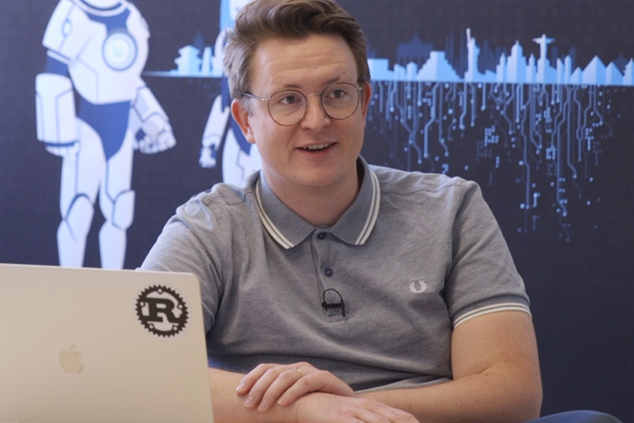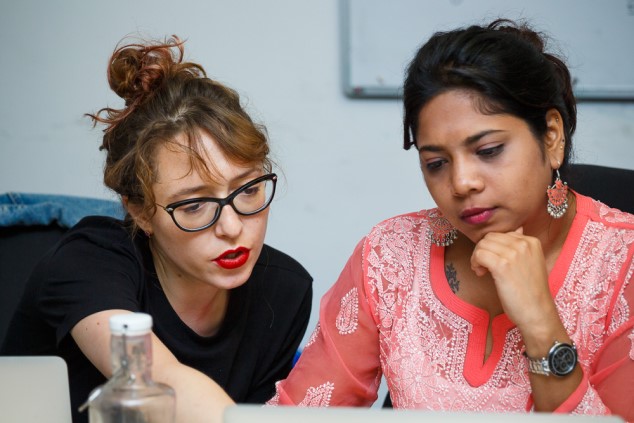We’ve asked Lars, our CTO, a few questions about how he remembers the first hackathon we ever hosted. Let’s see if there’ll be another one soon!

Who came up with the idea for the first InterNations hackathon?
It wasn’t me who had the idea for the hackathon. Of course, I was familiar with the concept in general, and it wasn’t hard to persuade me. Originally, the idea itself came from one of my teams, the Mobile Apps Team, to be more precise.
Their job is to build our new mobile platform, and their work can be quite different from that of some other teams in product development and engineering. The hackathon presented the perfect chance to work across teams on various topics, to try out new things in a completely different setting, and that’s the motivation out of which the very first InterNations hackathon — the InterHack 0.0.1 —was born.
What was the purpose of hosting the InterHack 0.0.1?
As I just mentioned, the idea behind a hackathon is to explore all the things we typically don’t have time for when following an agenda with a strong focus on business impact. Being goal-oriented means being less playful, less interested in exploration — which is obviously the right mode for professional software development in a company, but it also limits the possibilities of what we can look into.
Trying out something new, working with different people, applying different skills, and breaking up the usual office routine are all great reasons to organize and participate in a hackathon. In brief, it’s all about wearing different hats. A hackathon also provides an excellent opportunity for people who normally don’t have a leadership role to give this a try and bring a small project from inception to completion.
Having fun is an important part, too, but since we purposefully limited the scope to projects somehow related to InterNations, acquiring some knowledge as an organization played a certain role, even if applicability didn’t matter as much. For example, one group tackled a very tough infrastructure project. They looked into simulating external services, like payment-processing providers, under testing conditions, which is a very ambitious issue to solve within such a short time. They didn’t get very far with the solution, but they developed a much better understanding of the problem in the end.

How was the hackathon organized?
The hackathon itself lasted for three days. Anyone could brainstorm a potential project, sign up as a leader, and submit their suggestion in advance. The only two rules were: first, the project should be relevant to InterNations members, employees, or the company as a whole; second, it should state a clearly defined problem to be solved.
We started on Wednesday morning with the project leaders pitching their ideas and others joining the respective team if they were interested. We officially started hacking around lunchtime and continued for the next two days until it was time to prepare the final presentations. On Friday afternoon, each team presented the state of their project to their colleagues, and then our jury chose the winner for the award ceremony.
It was an intense experience — fun, frustrating, successful, energizing, just like the emotional rollercoaster that software engineering can be from time to time.
Which projects did the competing teams work on?
There were nine projects in total, including the one I pitched. My team worked on the most boring topic in the world, trying to improve our continuous integration environment. That’s all the automated stuff that happens after somebody changes a piece of code, and it’s a rather critical piece of engineering infrastructure. We had zero chances of winning an award: since I was also a member of the jury, our project wasn’t part of the actual competition. But I rather enjoyed getting to work on practical things again, which isn’t my typical role as CTO. That was a lot of fun for me.
Other teams experimented with augmented reality, tried to find a way of using InterNations in a low- or no-connectivity environment, and developed an interactive map for our events. There was another event-related project that I remember very well, called “Instant Events”. This group wanted to make it possible to spontaneously organize events on our platform in a low-threshold, low-key kind of way. They really focused on making this process as simple as possible, which is one of the key factors for the success of such a product.
And which project emerged as the winner?
Another project I found very impressive was the virtual “InterNations Passport”. They redesigned the member profile to make it look more like an identity card. It would also include a QR code, allowing you to use it as an entrance ticket to join our events. Instead of passport stamps, members could collect various badges for being active on our platform, like the number of contacts they’d made or the official events they’d attended. The presentation was very nicely polished — the group had one of the visual designers on their team — and this project carried the popular vote.
The jury vote went to the Moon Community, though. This project addressed the question of how to provide a space where we — i.e. all InterNations employees — can freely enjoy our community space without being visible to regular members. For example, our interns could simply create a private activity to meet for drinks at the bar across the street. The team came up with the moniker of “Moon Community” as a kind of code name for this outlandish place where nobody would live but us. I very much liked the idea because of its practical nature. Also, I think that regularly trying and using your own product is essential for any company.
The prizes consisted of a big table full of gadgets and goodies to be distributed on a “first come, first served” basis, with the winners obviously coming first. People could choose whatever they wanted. There were a couple of GoPro cameras, Amazon Echo dots, Bluetooth speakers, but also smaller items like board games, that sort of thing.

What’s your favorite hackathon memory?
My favorite moment? I think that must have been Marc, our Team Lead Backend Development, dressing up as Bob Ross, that TV painter guy with the “happy little clouds” and the “happy little trees”, in order to pitch his idea. His personal pet peeve — Marc’s, not Bob’s — is having proper visual documentation for all our core user stories. Therefore, he put on a wig, grabbed a paint brush and pretended to draw some “happy little diagrams”.
And then there was all of Thursday night. There weren’t any hard-and-fast rules concerning working hours, and people didn’t have to stay after dinner at 18:00. Quite a few team members did stay quite long, though, and we organized a games night on Thursday, with people playing board games or charades, watching soccer or hosting a LAN party. As is my nature, I had to stay until the very end, which was around 1:30-ish, I think. There’s even a bit in the official hackathon video that was shot on the day after, with me talking about how I still look “quite deranged”.

Will any of the projects be implemented soon? And will there ever be an InterHack 0.0.2?
I don’t think any InterHack projects will be implemented as is, so to speak. This is fine by me. A lot of the topics we briefly touched upon will become important in the months and years to come, and then you can’t help remembering what we discussed and did during the hackathon. However, there will definitely be another InterHack this year. The exact timing remains to be seen.
How would you sum up the hackathon in one word?
Positive energy. This is actually two words, but I don’t care.
Photo credits: InterNations
[…] If you want to know more about what working as a software engineer at InterNations is like, just have a look at our corporate blog — featuring, for example, the story of the first InterNations hackathon! […]